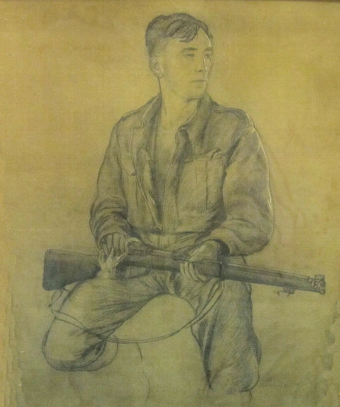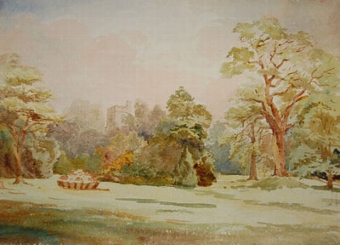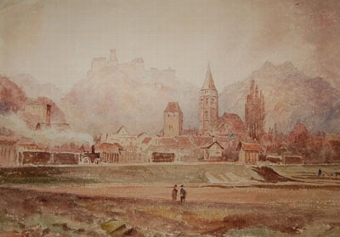brinkburn priory and manor house, rothbury , northumberland
- View other items in:
- antiques interior design modern and vintage
- other interior design
artware ltd
Enquire about this antique
Artware Ltd has 565 antiques for sale.
click here to see them all
Brinkburn Priory nestles in quiet seclusion in a bend of the River Coquet about four miles east of Rothbury, in Northumberland: owned by the Fenwick family it is now administered by English Heritage. Founded between 1130 and 1135 by William Bertram, Baron of Mitford as a house for Augustine canons the priory was never very wealthy. Little is known of the history of the house other than that gleaned from the records now housed in the British Museum. It survived some troubled times and as late as 1419 was raided and robbed. In 1535 the value was recorded as ?69 and the house was finally dissolved in 1536 along with all those other minor houses with an income of less than ?200. Services continued to be held at Brinkburn and the church was retained in a fair state of repair until the end of the 16th century. In 1602 it was reported to be in a state of decay, a situation which worsened over the years and eventually the roof collapsed. In the middle of the 18th century Dr Sharpe, Archdeacon of Northumberland tried to effect repairs and although there was considerable support for the project, work could not continue due to a dispute between the owner, William Fenwick, and the Vicar of Felton. In the 19th century the owner of Brinkburn tried to revive the restoration of the church and work began in 1858. The roof was completed along with a number of masonry repairs in 1859 and the stained glass windows inserted between 1861 and 1864; but the church was not furnished till 1868.
During the reconstruction the tombstone of Prior William, suffragan Bishop of Durham who died in 1484, was found and the original altar stone with five crosses is still preserved along with an ancient font. In 1834 another discovery was made about 50 yards from the church when a bronze pot containing almost 300 Rose Nobles of Edward III, Richard II, and Henry IV was discovered. Tradition tells of a party of marauding Scots who were unable to find the priory, although close by. The band failed in their bid to plunder and started off for home when they were startled to hear the sound of bells, which the monks rang in joy at their departure. The Scots returned, following the sound of the bells, and the priory was pillaged and burned. Nearby, a deep part of the river bears the name of "Bell Pool" - tradition relates that during one of their raids the Scots flung the priory bells into the river at this spot. It was founded by William Bertram, Baron of Mitford, in the reign of Henry I as an Augustinian priory. The exact date is not known but cannot have been later than 1135 as Henry died that year. About 1180 or so, Brinkburn became an independent house, and the building of the monastic church was commenced. Although the Priory acquired lands in Northumberland and Durham over the years it was never particularly wealthy. Little is known of the early history of the priory, although it is know that it survived some difficult times. In fact, as late as 1419 it was raided and robbed.
In 1535 the value was recorded as ?69 and the priory, having an income of less than ?200 per annum, was finally dissolved in 1536. Services continued to be held at Brinkburn and the church was retained in a fair state of repair till the end of the 16th century. In 1602 it was reported to be in a state of decay, and before 1700, the roof had collapsed, regular services were abandoned, and the site was deserted. The estate was purchased by the Fenwick family and in the late 16th century they built a manor house on the runs of the Priory buildings and adjacent to the ruins of the Priory Church. In the 1750s Dr Sharpe, Archdeacon of Northumberland tried to effect repairs to the ruin. However, despite there being considerable support for the project, work was not able to commence due to a dispute between the owner, William Fenwick, and the Vicar of Felton. In the 19th century the Cadogan family, owners of Brinkburn revived the restoration of the church and work began in 1858. The roof was completed in the space of a year, and the stained glass windows had been inserted by 1864. The church, however, was not furnished until 1868. The tombstone of Prior William, Bishop of Durham (died 1484) was found during the reconstruction, as was the original altar stone with five crosses. The latter is still preserved along with an ancient font. In 1834 a bronze pot containing 300 Rose Nobles of Edward III, Richard II, and Henry IV was also discovered. Brinkburn Priory today, is a very sympathetic 19th-century restoration of the medi?val original. On the site of the west range, is an early-19th-century manor house which utilizes part of the vaulted undercroft to the monks dining hall. Church services and concerts are still occasionally held here, but mostly, Brinkburn Priory today is a peaceful and tranquil place.
Antiques.co.uk Ref: 4YJXMCEV
- Materials:
- Oil on Canvas
- Width (cm):
- 40.64 x 55.88 cm 16.00 x 22.00 ins
Artware Ltd
Artware Fine Art specialises in fine antique, decorative and historical portraits and topographical pictures . We cover a period from the 17th and 18th centuries through to the 19th & 20th Centuries. We have over 150 portraits in stock, which can be viewed on our web site, each historical portrait has well researched biographical information both on the sitter and the artist.
Contact details
18 La gare
51 Surrey row
London
Greater London
SE1 0BZ
UNITED KINGDOM
T: 0207 921 97904
E: greg@artwarefineart.com
W: www.artwarefineart.com














